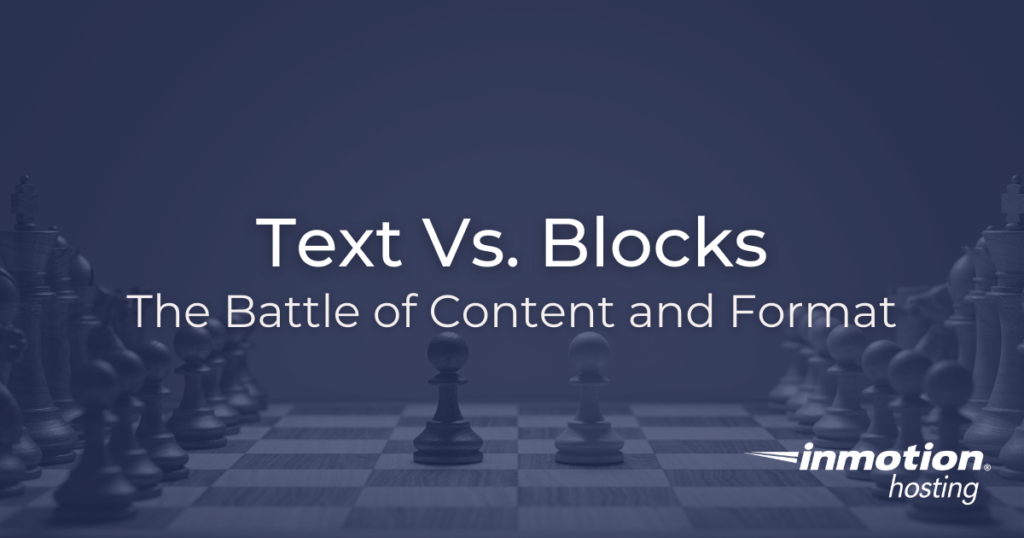
You have no doubt noticed that the WordPress approach to content creation is changing. The emphasis has shifted more toward on-page editing in the browser. This essentially means blocks over text. The pros and cons of taking a content first approach as opposed to an all-in-one design and content approach can produce different results. Each approach provides unique opportunities as well as trade-offs.
Text Vs Blocks: Differences Between Content and Format
Content is separate from format. Which is why you can write a webpage in plain text and have it eventually rendered in a completely different format. So there are two approaches to creating written website content consistently and quickly. In this article, we will explore both approaches.
Content First Approach
If you take the content first approach, you are emphasizing the creation of high quality written content first and separating it from the design process. This approach is (usually) facilitated by a simplified markup for written content first drafted in plain text. (See: markdown.)
The primary benefit of this approach is to free up the writer from the constraints of design consideration. Even in the rare case that the writer is also serving as designer, a content first approach will focus on one or the other separately instead of trying to do both at the same time.
In the case of a WordPress site, the process would follow a workflow similar to this:
- Content is written in a plain text document with no formatting, likely using a simplified markup syntax to denote special formatting that will take effect later
- The content is exported to HTML or pasted as is into WordPress
- CSS takes the simplified markup (or converted HTML) and applies formatting to it
Notice how content is organized, drafted, and finalized before formatting is applied. The benefit for the writer is that they don’t have to stop in the heat of composition to click around the interface adding italics, bolding, centering, or other formatting styles. These are all applied automatically later.
The down side of the content first approach is that if you spend too little time working on design, your website may look unattractive or be difficult to read. This is why, when in doubt, choosing a base WordPress theme, with proper mobile responsiveness, is not a bad idea to start out. But, eventually, you should consider bringing in help for the design side. It is not at all the case that design is less important than content. But a content first approach means that content considerations are given individual focus in the initial phases, and design is likewise given its own due consideration when written content has been finalized.
All-in-One Approach
The WordPress block editor is a great example of an all-in-one that merges content creation and formatting.
The benefit of this process is simplicity. You don’t need to create a system for generating content or start out in the plain text world. A base WordPress installation, or other content management system, provides the interface as is. The user merely has to create the content within the interface, stop to pick and choose desired formatting, and publish when ready.
For websites that are heavily theoretical, and depend on long form written content, this approach will likely starve the content side while emphasizing more design. In the end, you will probably end up with a little mix of both, but neither great content nor stellar design.
Also, an all-in-one approach can make simple content issues more complicated. For example, footnotes and cross-references, critical for more scientific or information-dense websites, are not easy to implement by default, and require some forethought to integrate into a content workflow. However, for some plain text markups, footnotes and cross-reference features are built-in.
Mixing Both Approaches
As is often the case with complicated website logistics, a healthy balance of different considerations may provide the best results. For example, if you are producing an information-dense, scientific, or otherwise word-heavy website, it would be best to spend more initial effort in designing a content first system. Make certain that your content creation process provides all the markup you need, including higher-level organizational elements like footnotes and cross-references. Then, build a visual style and design that best complements the written content. Remember you can always farm out the design process to a professional firm or freelance designer.
On the flip side, if you are building a more visual-heavy site — for example, an artist’s portfolio or marketing site — you’re in luck. There are many great page-builder applications available that come with pre-built themes you can easily customize.
Check out these other resources from InMotion Hosting: